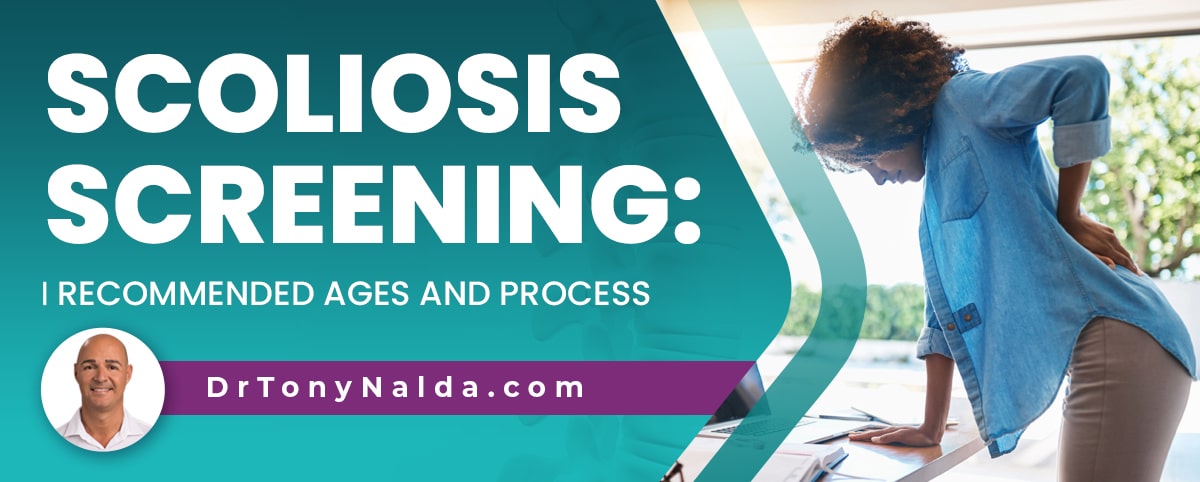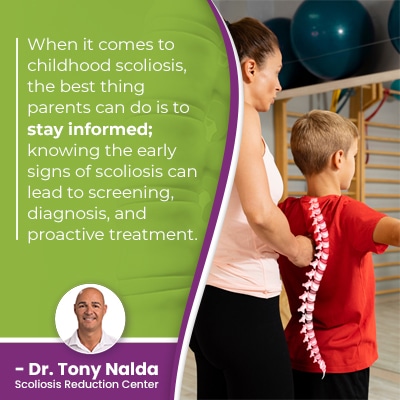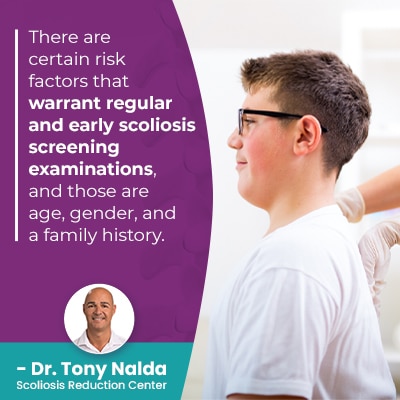Scoliosis Screening: Recommended Ages and Process

For those with a family history of scoliosis, regular screening is recommended because it increases the likelihood of another member being diagnosed. While scoliosis affects all ages, it's most often diagnosed in children, and as a progressive condition triggered by growth, screening should be started prior to a child's first pubescent growth spurt.
Scoliosis screening can lead to early detection, which is associated with treatment success. There are no treatment guarantees, but when diagnosed and treated early in the condition's progressive line, the spine is most likely to respond well.
Before getting to the specifics of scoliosis screening and age recommendations, let's talk about what makes early detection beneficial.
Table of Contents
The Benefits of Early Detection
Scoliosis is a progressive condition, meaning its nature is to become more severe over time, and this is why it can be beneficial to start treatment early in a condition's progressive line; the more scoliosis progresses, the more difficult it can be to treat.
As scoliosis progresses, the size and rotation of the unnatural sideways-bending spinal curve will increase, as will the condition's uneven forces, and their effects.
Progression makes the spine increasingly rigid, and this can make it less responsive to treatment, and increasing spinal rigidity can also make it difficult for some patients to perform key therapeutic exercises as part of treatment.
The effects of scoliosis increase with progression, so the best way to minimize the condition's effects is to treat it proactively, and when it comes to scoliosis screening, there was a time when schools across the United States had a mandatory screening program managed by a school nurse.
School screening for scoliosis no longer occurs, shifting the onus of early detection onto the shoulders of parents and/or caregivers, and patients themselves.
When it comes to childhood scoliosis, the best thing parents can do is to stay informed; knowing the early signs of scoliosis can lead to screening, diagnosis, and proactive treatment.
What is Scoliosis Screening?
 Screening for scoliosis means examining patients for condition indicators.
Screening for scoliosis means examining patients for condition indicators.
As we know growth triggers progression, the ultimate goal is to diagnose scoliosis in children prior to the first significant pubescent growth spurt so treatment can be started early before the risk of rapid progression caused by growth spurts.
The most popular scoliosis screening examination is known as the Adams test, and this involves a patient starting in a standing position with arms at their sides, bend forward at the waist with arms dangling at the sides.
A professional will stand behind the patient and examine the spine in this highly-visible position.
The main effects of scoliosis in children involve postural changes caused by the condition's uneven forces disrupting the body's overall symmetry, and during a forward bend test, not only is the spine highly visible, but also any trunk asymmetries.
So if a child is taken in for a screening examination, the goal is to determine whether further testing is needed to detect scoliosis and officially diagnose the structural spinal condition.
In children, often it's uneven shoulders, shoulder blades, and hips that are the earliest signs.
If a screening examination finds scoliosis-indicators, in order to officially diagnose scoliosis, an X-ray is needed.
How a Scoliosis Diagnosis is Reached
Scoliosis is diagnosed through a combined physical examination and X-ray results.
In order to be considered a true scoliosis, the spine has to have an unnatural sideways bend, and there also has to be a rotational component, and the size of the scoliotic curve has to be a minimum of 10 degrees.
Curve size is what determines condition severity, and scoliosis ranges from mild scoliosis to moderate, severe and very severe scoliosis.
Cobb Angle Measurement
An X-ray is needed to confirm the rotational component and to determine a patient's Cobb angle measurement based on the size of their curve.
Cobb angle is determined by drawing lines from the tops and bottoms of the curve's most-tilted vertebrae, and the resulting angle is expressed in degrees.
The higher a patient's Cobb angle, the more severe the condition, and the more likely it is that the condition's effects will be noticeable.
In children, the main effects of scoliosis involve postural changes caused by the condition disrupting the body's overall symmetry, and in adults, it's pain.
Scoliosis can be painful, but isn't for everyone; the condition becomes compressive once skeletal maturity has been reached, and compression is the main cause of condition-related pain.
Compression is uneven pressure, and it doesn't just affect the spine, but also its surrounding muscles and nerves.
Being aware of the condition's early signs can help lead to early detection, and when it comes to scoliosis screening, there's no harm in starting early, but there is a potential danger of starting later, or not screening at all, and that is that scoliosis could be present and progressing unimpeded.
When Should Scoliosis Screening Start?
The Scoliosis Research Society has current estimates at close to seven million people living with scoliosis in the United States alone, and as the most common spinal condition among school-aged children, screening is important.
Screening is important because it can lead to early detection and early intervention, which makes treatment success more likely.
There are certain risk factors that warrant regular and early scoliosis screening examinations, and those are age, gender, and a family history.
Scoliosis Risk Factors
 The most common form of scoliosis overall is adolescent idiopathic scoliosis diagnosed between the ages of 10 and 18, and this age group is the most at risk for rapid progression because of the stage of puberty and its rapid growth; remember, progression is triggered by growth spurts.
The most common form of scoliosis overall is adolescent idiopathic scoliosis diagnosed between the ages of 10 and 18, and this age group is the most at risk for rapid progression because of the stage of puberty and its rapid growth; remember, progression is triggered by growth spurts.
So children going through periods of significant growth should be regularly screened, and as females are more likely to be diagnosed with scoliosis and are more likely to experience progression, gender is another factor that can warrant early screening.
A family history of scoliosis is also considered a risk factor, but this is more because of the condition's familial nature, rather than genetic.
So if scoliosis isn't genetic, why is having another family member with scoliosis considered a risk factor?
Is Scoliosis Genetic?
Despite the amount of research and studies attempting to find a single gene, or combination of genes, that accounts for the development of scoliosis, one has yet to be identified, and remember, families share a lot more than just their genes.
Families share socioeconomic factors, geography, lifestyle, diet, posture, responses to stress, and more, and as idiopathic scoliosis is considered multifactorial, any one of these factors, or a combination, could be the catalyst for scoliosis development.
So if you are female, approaching adolescence, and have another family member who has already been diagnosed, it's wise to be proactive by watching for signs of postural changes and/or disruptions to gait, balance, and coordination.
Checking for changes with a forward bend test and going for regular screening exams with a medical professional should be started prior to the start of puberty because if an adolescent develops scoliosis around the age of 10, and the growth spurts of puberty don't start until 12, in the interim, treatment could have been started and progression may have been prevented.
As females tend to start puberty sooner than males, scoliosis screening is recommended to start around the age of 9, prior to when most adolescents have had their first significant pubescent growth spurt; however, if there are relevant risk factors, scoliosis screening should be performed as part of regular checkups throughout childhood.
A child's doctor can perform scoliosis screening as part of regular check ups, and this is being proactive with scoliosis screening and can lead to early detection and intervention.
Here at the Scoliosis Reduction Center®, more treatment options are applied to work towards preventing progression, increasing effects, and the need for invasive surgery.
Conclusion
Screening for scoliosis should be performed regularly in children because it's a progressive condition triggered by growth.
So screening for childhood scoliosis should be started prior to the start of puberty; adolescents are at risk for rapid-phase progression because of the growth spurts of puberty.
Screening can lead to an early diagnosis and starting treatment early in a condition's progressive line, when it's likely to respond well.
For children with risk factors such as age, gender, and a family history, regular screening should be integrated into regular check ups; this way, at the earliest sign, scoliosis can be detected, diagnosed, and treated proactively.
The complexity of scoliosis treatment is that the condition's signs can be subtle, until enough progression has occurred to make the symptoms more overt, but this also makes the condition more difficult to treat, hence the benefit of proactive treatment that works towards preventing progression.
A child's spine is going to be more malleable than an adult's, and when it comes time to treat scoliosis, the more flexible a spine is, the more likely it is that it will respond well to treatment, and progression also makes the spine increasingly rigid.
If a spinal curvature is detected while mild, curve progression can be easier to manage; as a progressive condition, there is no curing scoliosis.
Scoliosis treatment is about how best to manage an ongoing condition for the best quality of life, and when it comes to childhood scoliosis, most children require treatment, and most patients don't want to undergo invasive spinal surgery.
The longer scoliosis is left undiagnosed and/or untreated, the more likely it is that complications will develop over time and surgical intervention will be recommended in the future.
Dr. Tony Nalda
DOCTOR OF CHIROPRACTIC
After receiving an undergraduate degree in psychology and his Doctorate of Chiropractic from Life University, Dr. Nalda settled in Celebration, Florida and proceeded to build one of Central Florida’s most successful chiropractic clinics.
His experience with patients suffering from scoliosis, and the confusion and frustration they faced, led him to seek a specialty in scoliosis care. In 2006 he completed his Intensive Care Certification from CLEAR Institute, a leading scoliosis educational and certification center.
About Dr. Tony Nalda
 Ready to explore scoliosis treatment? Contact Us Now
Ready to explore scoliosis treatment? Contact Us Now





